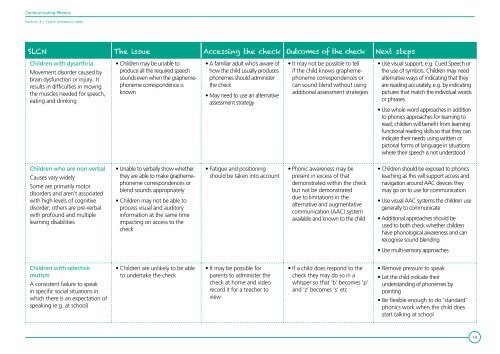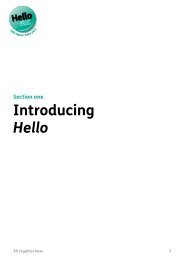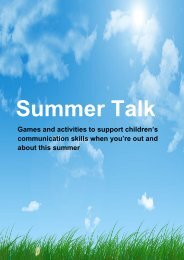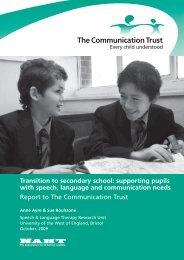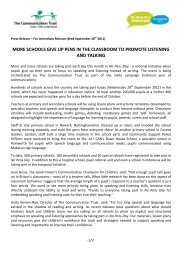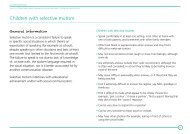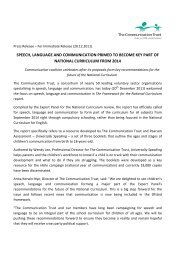Communicating Phonics - The Communication Trust
Communicating Phonics - The Communication Trust
Communicating Phonics - The Communication Trust
You also want an ePaper? Increase the reach of your titles
YUMPU automatically turns print PDFs into web optimized ePapers that Google loves.
<strong>Communicating</strong> <strong>Phonics</strong>Section 3 > Quick reference tableSLCN <strong>The</strong> issue Accessing the check Outcomes of the check Next stepsChildren with dysarthriaMovement disorder caused bybrain dysfunction or injury. Itresults in difficulties in movingthe muscles needed for speech,eating and drinking• Children may be unable toproduce all the required speechsounds even when the graphemephonemecorrespondence isknown• A familiar adult who’s aware ofhow the child usually producesphonemes should administerthe check• May need to use an alternativeassessment strategy• It may not be possible to tellif the child knows graphemephonemecorrespondences orcan sound blend without usingadditional assessment strategies• Use visual support, e.g. Cued Speech orthe use of symbols. Children may needalternative ways of indicating that theyare reading accurately, e.g. by indicatingpictures that match the individual wordsor phrases• Use whole word approaches in additionto phonics approaches for learning toread; children will benefit from learningfunctional reading skills so that they canindicate their needs using written orpictorial forms of language in situationswhere their speech is not understoodChildren who are non-verbalCauses vary widelySome are primarily motordisorders and aren’t associatedwith high levels of cognitivedisorder; others are pre-verbalwith profound and multiplelearning disabilities• Unable to verbally show whetherthey are able to make graphemephonemecorrespondences orblend sounds appropriately• Children may not be able toprocess visual and auditoryinformation at the same timeimpacting on access to thecheck• Fatigue and positioningshould be taken into account• Phonic awareness may bepresent in excess of thatdemonstrated within the checkbut not be demonstrateddue to limitations in thealternative and augmentativecommunication (AAC) systemavailable and known to the child• Children should be exposed to phonicsteaching as this will support access andnavigation around AAC devices theymay go on to use for communication• Use visual AAC systems the children usegenerally to communicate• Additional approaches should beused to both check whether childrenhave phonological awareness and canrecognise sound blending• Use multi-sensory approachesChildren with selectivemutismA consistent failure to speakin specific social situations inwhich there is an expectation ofspeaking (e.g. at school)• Children are unlikely to be ableto undertake the check• It may be possible forparents to administer thecheck at home and videorecord it for a teacher toview• If a child does respond to thecheck they may do so in awhisper so that ‘b’ becomes ‘p’and ‘z’ becomes ‘s’ etc• Remove pressure to speak• Let the child indicate theirunderstanding of phonemes bypointing• Be flexible enough to do ‘standard’phonics work when the child doesstart talking at school14


